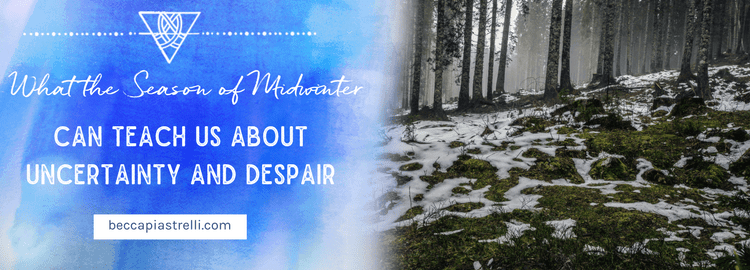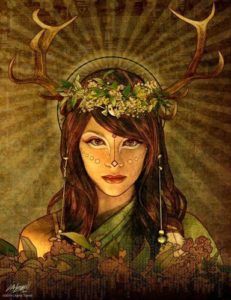
Most of my life, I’ve had an aversion to Februaries.
It was a bitter joke in my family that we couldn’t be responsible for who we’d become during that dark, cold month because it was always sad and a little bit ugly. The novelty of the winter holidays had worn off and now it was about trudging through cold slush praying that spring would come again.
That the warmth of the sun would shine on my face.
That wildflowers would sprout up again.
That joy and hope would return.
If you have felt (or still feel) the same way about this time of year, it makes sense.
For thousands of years, our ancestors were doing the same thing – praying for an end to the dark, cold winter so they could get back out in the world and keep living. Winter truly was a fragile time for humanity – when simply surviving it was the only priority.
I believe that, even in this time of prescription sunlamps, vitamin D drops, and jetting off to Miami for a weekend of sunshine, we can still feel this tension of winter in our bones.
…which is why, when I started to embrace living in tune with the seasons, I could find more wisdom in these harder moments of the year.
I have been able to flow more with the uncertainty that winter brings us.
This week (the beginning of February) marks the Celtic celebration of midwinter – called Imbolc (pronounced EE-molc) – marked by the halfway point between the winter solstice and the spring equinox.
Imbolc is a festival of hearth and home – of lengthening days and watching for the early signs of spring. It celebrates the changing of the goddess (earth) from crone (winter) to maiden (spring). It is a time to remind ourselves that winter is passing through and spring is on its way. There is a quickening in the soil below and it’s starting to warm as the crocus flowers are beginning to bloom. It also happens to coincide with Groundhog Day here in the U.S. – the time we check with Punxsutawney Phil to see how much longer winter will last (I love seeing the synchronicities of different cultures and religions around nature’s holidays).
Imbolc is also a time to celebrate Brigid – the Goddess of the Hearthfire, Poetry, Healing, Smithcraft, and Midwifery.
If you can make it with you hands, you can thank Brigid for it.
Traditionally at Imbolc, people would make Brigid’s crosses</a”> and Brigid dolls to represent fertility, fortune, and awakening to nature. To receive Brigid’s blessings, they would light candles and fires (representing the warmth returning) and feast in her honor would make a bed for Brigid and leave her food and drink, while items of clothing would be left outside for her to bless that night.
I find the tradition Imbolc to be a deep comfort during this tenuous time of winter – not only in nature but also in this time in history when despair, uncertainty, and fear dominate the headlines.
“Imbolc in dark, cold winter can signify endurance in the face of adversity and scarcity: we may encounter fragility, tenuousness, uncertainty, darkness and despair beyond what we think we can endure. Women know these experiences. We have held both new life and death in our hands. We have wondered: will this child make it, will the addict live or die, will my lover come home, will I survive this loss? Will I be ok? Will there be enough resources to see us into spring?⠀
I imagine our ancestors sitting in circle at this time of year, with whatever sources of light they had, listening to one another. Just so, we are invited to sit circle together and share how we “are,” what we need, what is frozen, what is thawing, what is fragile. In the deep winter, be begin again. We say YES again each year. Yes to returning light, to the coming outward time. We are saying yes to the living of life again and whatever it may it bring. I speak of Imbolc as a time of faith.
– Words from Kim Duckett found in my We’Moon Calendar
Whether you are physically experiencing the effects of mid-winter where you live right now or are feeling it in your body and heart, we can learn so much from this seasonal moment in the wheel of the year.
It is a time of deep faith.
During this emotionally tenuous time in history, when it can be so tempting to lose yourself in rage, fear, and hopelessness, I’ve been asking myself “Who do I need to be?” and weighing it just as important as “What do I need to do?”.
And my answer always comes back the same: Take exquisite care of myself.
And so I move my body. I go to bed early. I make my bone broth. I take candlelit baths. I walk in nature and notice what she has to say to me.
…all so I can show up and keep fighting for love.
Here are some ideas for a simple ritual you can do to cultivate faith and nourish your feminine creativity this midwinter:
- Light a candle (or a fire) when the sun goes down and be with the warmth of the light to welcome back the sun.
- Contemplate and journal on the seeds you want to plant and nurture this year. You could also place some physical seeds on your altar or bedside table.
- Turn up some inspiring music and dance around – tidying your living space as you go to welcome in the newness of spring.
- Prepare yourself for the work ahead by blessing your tools. Lay out your gardening gloves, calculator, pens, laptop, etc, smoke cleanse them and infuse them with your intentions for the year.
- Activate your inner Brigid by making with your hands – nourishing foods, knit items, handwritten poems, maybe even try your hand at the Brigid doll I posted a link to above.
So now I ask you: How can you midwife yourself through this midwinter season to cultivate more faith that spring is coming to your life?
I’d love to read your answer in the comments below, sister.
